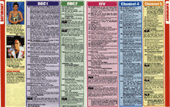

I constructed the televisual DNA by collecting information from people from all different walks of life. From fellow students to country pub regulars they were all given a copy of the latest TV magazine and with it they recorded everything they watched, or would have wanted to watch. With the information I collected I used each page of the tv magazine as a template and created a table on which blocks of colour were placed.
Each block of colour represented a programme which the viewer had circled or marked. With the resulting patterns I experimented with comparing different people's 'tv dna'. In box 2 to the right you can see one single day, each person represented by a different colour.
I then brought each day together and created a strip of the week's viewing in the form of the DNA strips used by scientists. In some cases a pattern can be seen through each person's viewing habits but in others it seems more irregular. This could, for example, suggest the presence, or absence, of a soap or regualr drama serial in their televisual diet. Comparisons can be made with other Televisual DNA which could reveal similarities in their habits, how much of a particualr channel a person watches and when they're more likely to watch.

